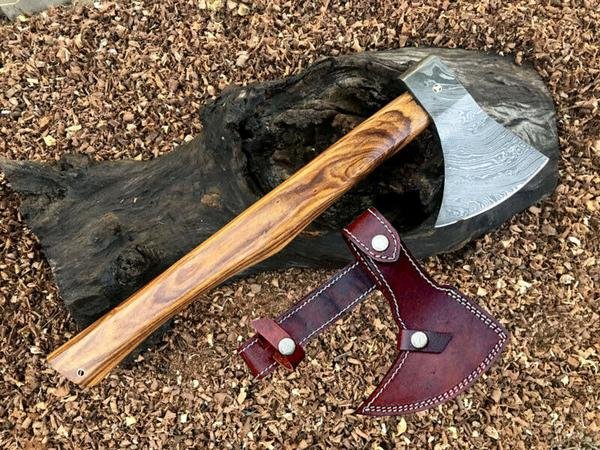All About Axes
For as long as there has been humans on this earth, there has been a need for sharp blades to cut and forage. From crude handmade tools made out of flint and wood, to pieces of art that have been lovingly crafted by artisan blacksmiths, Axes have been an ever-present in the work of bladed items. Equally, at home hunting animals, felling trees, or even being used as weapons in the bronze age, Axes have always been a useful tool to own. We all know what an Axe looks like, but less of us know of the many different varieties of an axe there are. In today’s article, we are going to be covering some of the different types of axes you can buy.
How axes are made
A typical axe will begin life as a block of low carbon steel. The initial stage is to chisel a hole within the block to form the eye of the axe. Next using a specialised tool called a mandrel, the eye socket is formed into the shape and size needed. Following this process, a notch is chiselled into the end of the billet, with a piece of steel in the shape of a wedge being inserted in order to create a hard cutting edge.
Once this basic axe shape has been created, the blade is now heated until it reaches a deep yellow glow. It is at this point that borax is melted onto the metal, which liquifies the oxidation scale and washes it out of the welding seam.
The next stage is the forging process. This sees the axe once again heated to high heat and forged in a way that the 2 individual sections of steel join together. A master blacksmith is then ready to shape the head of the axe and grind down the still rough edges until they are smooth.
The axe is now prepared for the next stage, where it will be annealed.
Annealing is the process of removing inner stresses that are present in the steel following the forging. To do this, the blacksmith heads the blade to around 850 degrees and then cools it down again at a slow rate until it reaches room temperature. Following a process known as normalising, the axe is then ready for hardening. Once again, the axe is placed back into the furnace and is heated back up to 80 degrees. At this point the blade is drenched in a mixture of mineral oil and water, leaving the blade very hard. The final stage is to make the blade less brittle, which is completed by heating the blade up to a temperature of 220 degrees, in a process known as tempering. The blade is maintained at this heat for over an hour and then treated to a coat of protection, usually in the form of beeswax, linseed oil and turpentine. This protects the blade against rusting. Finally, the blade is sharpened and the handle is attached.
Different types of axes
Battle Axe

When conjuring up an image of an axe in your head, the first thing a person is likely to picture is a typical battle axe.
Although these are less common in modern times, they continue to evoke a vivid picture of years gone by. These days the majority of battle axes sold are either for ornate purposes or to be used in role-playing events, as they do not offer the practicality for regular cutting or capping. That said, they are legendary in their nature and make for a fun and interesting decoration.
Viking Axe

Almost as evocative as battle axes, next comes the Viking Axe. We all know that Vikings were fierce warriors and their weapon of choice was the axe that has now been named after them. They are very different in design to the battle-axe and were designed purely as a weapon of combat. Given this, there are limited uses for such axes in the modern-day, and their large size means that they are less useful as house decoration.
Hatchet

At the opposite end of the size scale from a Viking axe is a hatchet. A hatchet is much smaller in size and is regularly used in the modern-day, as a companion on farms, woods or camping trips. They make a great tool for chopping wood, and although they are probably a bit smaller for large jobs, many people make use of these handy tools due to their relative availability and affordable cost.
Niche Professional axes

Some jobs require speciality tools when a large traditional axe or the more common hatchet just won’t suffice. We are talking about professional roles such as firemen and carpenters, who regularly need to use a niche product in order to excel in their trade.
Firemen for example regularly use axes and need a tool that is durable, easy to carry and also strong enough to break down doors. A fireman axe is a strong tool that has multiple purposes, working hard to save lives.
As with firemen, a carpenter is also a trade that requires a specific niche of the tool. An axe made specifically for carpenters is usually a smaller tool than other types of axes, almost being small enough to be considered a hatchet. This axe is perfect for one-handed use, and it can be manoeuvred easily, giving the carpenter the maximum amount of control that is needed for intricate carpentry work. Also, typically blades on carpenter axes are thinner, which allows for improved precision.
Tomahawk

Another tool from a bygone era, a tomahawk axe is not particularly useful or practical in the modern day. These days, tomahawk axes are mostly used for cutting firewood, but in reality, there is usually a different tool that would be more practical for such a job.
Originally used as war weapons by native Americans, tomahawk axes are still seen in the present day in competitions and shows, usually used for fun or exhibition purposes, such as in throwing competitions.
Double Bit Axe

These distinctive axes take their name from the fact that they have 2 heads. Although these are very unique to look at and stand apart from other axes, the 2 blades have very distinct uses, with one side of the blade significantly sharper than the other. Made for chopping and splitting wood, these can be quite a handful to get used to, but professionals who have the experience and strength needed are able to reap the benefits of essential having 2 axes for the price of
Splitting Axe

As the name suggests, this axe is most at home spitting wood, allowing for the easy cutting of logs in a consistent and even manner. Unsurprisingly, the axe was designed for that very job, with the head designed in such a way to split the wood evenly in two when struck.
Blade Material
Carbon Steel
The most popular choice of material used in the construction of axes is Carbon Steel. The ease of sharpening and anti-corrosion properties mean that it is the go-to choice for many. Another benefit to Carbon steel is its strength, being harder than other types of steel. This means that it retains its sharpness for longer, particularly when exposed to other hardened materials.
Although all types of steel have an element of carbon within them, carbon steels have a stronger mixture, consisting primarily of carbon and steel, but without the other types of compounds or alloys that is regularly seen in weaker grades of steel.
Carbon is the most important hardening element in all steel types and can help extend the life of the axes blade, although too much can reduce the toughness in the material, making it more susceptible to shock and damage.
Carbon is generally broken down into one of three sub-categories: low, medium, and high-level carbon. Medium and high are what you will most commonly find in many axes. Medium-level carbon has between 0.4 – 0.6% Carbon while high-level carbon has about 0.7 or 0.8% and above. As per the naming system developed by the SAE (Society of Automotive Engineers), plain carbon steel is encompassed in the 10xx number series.
Stainless Steel
Undoubtedly one of the most popular and common axe making materials is Stainless steel, a favourite due to the ease in which it can be maintained and withstand corrosion. The prominent ingredient in this steel is chromium, and there is a requirement for a minimum of 12% Chromium to be present in order for it to be considered stainless steel.
The most popular type of this steel found amongst axes and hatchets is 420 Stainless Steel. This material only has about 0.3% – 0.4% carbon, meaning that is fairly soft steel and has moderate edge retention. It is also incredibly corrosion-resistant, and stands up well to the elements, making it ideal for tools that are exposed to water or chemicals often.
Damascus steel
One of the more beautiful materials to build axes is Damascus steel. Not only is Damascus steel beautiful, but it also maintains its sharpness and strength whilst remaining hard yet flexible. The beautiful patterns seen on Damascus steel are attained during the forging process when the small steel ingots gradually form into the shape of a blade. By heating the steel to temperatures between 1,500F and 2,000F, results in the alignment of iron carbides that forms into bands which in turn make the beautiful and unique patterns found on Damascus steel axes. After heating, the steel is cooled and stacked for 10 minutes, before being bathed in liquid nitrogen, before undergoing a dual tempering process. Finally, the blade is finished by buffing and then being submerged in sodium phosphate which neutralises the finish.
Axe Handles
Axe handles are generally made from 1 of 3 materials. Wood, Fibreglass or Steel.
Wood is the original and most common choice, with axe enthusiasts from around the world considering ash or hickory handles to be the best you can have for any type of axe. Wood is great at absorbing shocks and also has the benefit of being the cheapest of the three types.
The next most common type of handle is fibreglass. Initially created 50 years ago, fibreglass handles are generally stronger than wood and as a result, can take more punishment than traditional wooden handles. Fibreglass handles have fantastic shock absorption properties and are very durable. However, the downside is both the cost, generally being more expensive than wood, and the fact that they are hard to replace.
The rarest type of handle to find on an axe is steel. Steel handles are incredibly durable, usually meaning that the axe handle and head are made from a single piece of steel. The downside is that steel handles transmit the most shock into your hands, which can cause long term problems with joints and bones if you are conducting a lot of cutting and chopping. Another consideration with steel handles is the weight, coming in at the heaviest of the 3 different types.
Sheaths
Undoubtedly, the most popular material for an axe sheath is Leather. Leather is certainly the most traditional material choice, and a good quality leather sheath is usually more durable and secure. Another option is Kydex, which is waterproof and can be contorted easily to allow for a better fit over the axe blade. Given the affordability of Kydex, these sheaths are growing in popularity, but for the most part, leather is the undisputed king.

